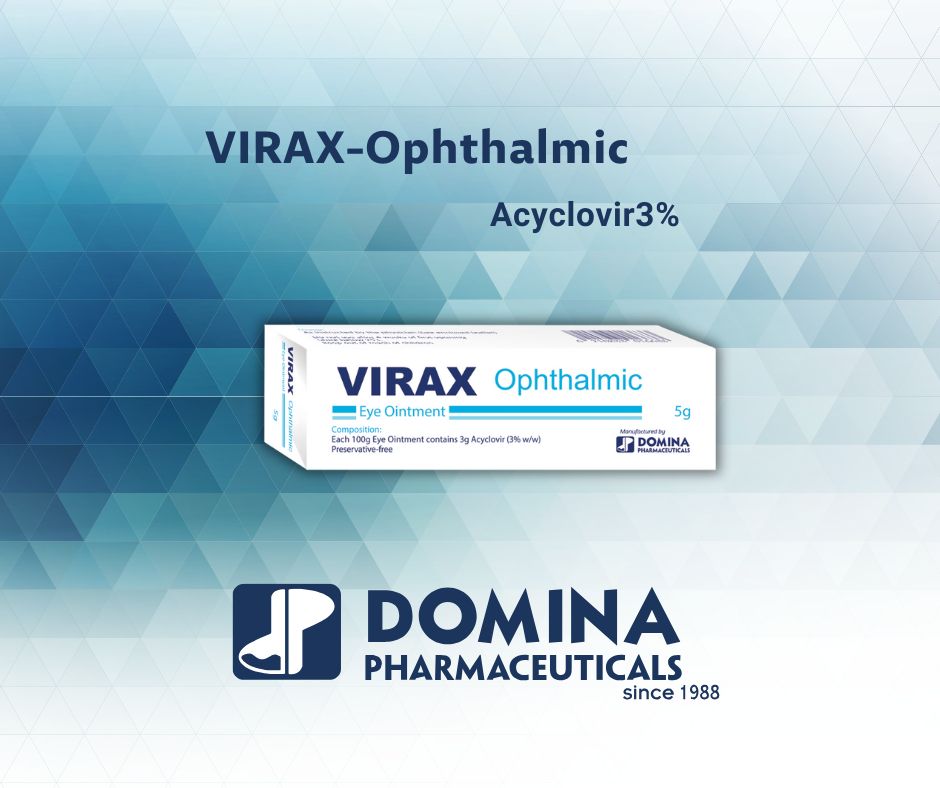
What is Virax ophthalmic ointment?
Virax is an antiviral medication. The active ingredient is Acyclovir (ACV) 3% ophthalmic ointment.
What is Virax ophthalmic ointment FDA approved for?
Acyclovir eye ointment was FDA approved in 2019 for the treatment of acute herpetic keratitis in patients
with herpes simplex (HSV-1 and HSV-2) virus in children ≥2 years, adolescents, and adults
What is Acyclovir mechanism of action?
Acyclovir is converted to acyclovir monophosphate by virus-specific thymidine kinase then further converted to
acyclovir triphosphate by other cellular enzymes. Acyclovir triphosphate inhibits DNA synthesis and viral replication
by competing with deoxyguanosine triphosphate for viral DNA polymerase and being incorporated into viral DNA
What do the studies on Acyclovir say?
Acyclovir 3% ophthalmic ointment is the preferred topical treatment for herpetic keratitis
A 2015 systematic review of 106 trials found that any of four topical antiviral agents (trifluridine, acyclovir, ganciclovir, or brivudine)
were equally effective and resulted in healing of 90 percent of eyes within two weeks
A 2015 systematic review and meta-analysis of 7 trials compared the efficacy of acyclovir 3% ophthalmic
ointment to idoxuridine in curing herpetic keratitis by Day 7 of treatment. The results showed on average the day 7 healing rate was
79% (95%CI: 67%, 87%) for ACV and 47% (95%CI: 34%, 61%) for IDU.
Regarding dendritic ulcers, on average, the day 7 healing rate was 87% (95% CI: 59%, 97%) for ACV and 56% (95% CI: 24%, 83%) for IDU.
For geographic ulcers, the average day 7 healing rate was 54% (95% CI: 10%, 93%) for ACV and 18% (95% CI: 2%, 71%) for IDU
How is Virax eye ointment dosed?
Apply a 1 cm ribbon in the lower eyelid of affected eye(s) 5 times a day (~every 3 hours while awake) until corneal ulcer heals,
then apply a 1 cm ribbon 3 times daily for 7 more days. Avoid touching tip of applicator to eye or other surfaces.
Instruct patient to close eye(s) for 1 to 2 minutes following application
Can Virax ophthalmic ointment be used in pregnant and breastfeeding women?
Pregnancy and breastfeeding considerations: Acyclovir has not been detected in the blood following ophthalmic
administration; limited systemic absorption would limit potential exposure to the fetus
Can patients wear contact lenses while on treatment?
Contact lenses should not be worn during the course of therapy or in any patient with signs/symptoms of herpetic keratitis
Benefits of Virax ophthalmic ointment
- Preferred topical treatment for herpetic keratitis
- Safe in children and pregnant patients
- Has a safe side effect profile
References:
1. Griswold A. FDA approves Avaclyr for herpetic keratitis 2019 [Available from: https://www.aao.org/education/headline/fda-approves-acyclovir-ophthalmic-ointment-herpeti.
2. Lexicomp. Aciclovir [Acyclovir] (Ophthalmic) 2022 [Available from: https://online-lexi-com.ezproxy.lau.edu.lb:2443/lco/action/doc/retrieve/docid/multinat_f/4670671?cesid=42G5qwQTCaw&searchUrl=%2Flco%2Faction%2Fsearch%3Fq%3Dacyclovir%26t%3Dname%26acs%3Dfalse%26acq%3Dacyclovir.
3. Sugar A, Jacobs D, Hirsch MS, Givens J. Herpes simplex keratitis 2022 [Available from: https://www.uptodate.com/contents/herpes-simplex-keratitis?search=herpetic%20keratitis%20treatment&source=search_result&selectedTitle=1~33&usage_type=default&display_rank=1.
4. Wilhelmus KR. Antiviral treatment and other therapeutic interventions for herpes simplex virus epithelial keratitis. Cochrane Database Syst Rev. 2015;1(1):Cd002898.
5. Balderson DE, Cai G, Fries MA, Kleinman DM, McLaughlin MM, Trivedi TM, et al. A systematic review and meta-analysis to compare the efficacy of acyclovir 3% ophthalmic ointment to idoxuridine in curing herpetic keratitis by Day 7 of treatment. BMC Ophthalmol. 2015;15:42.